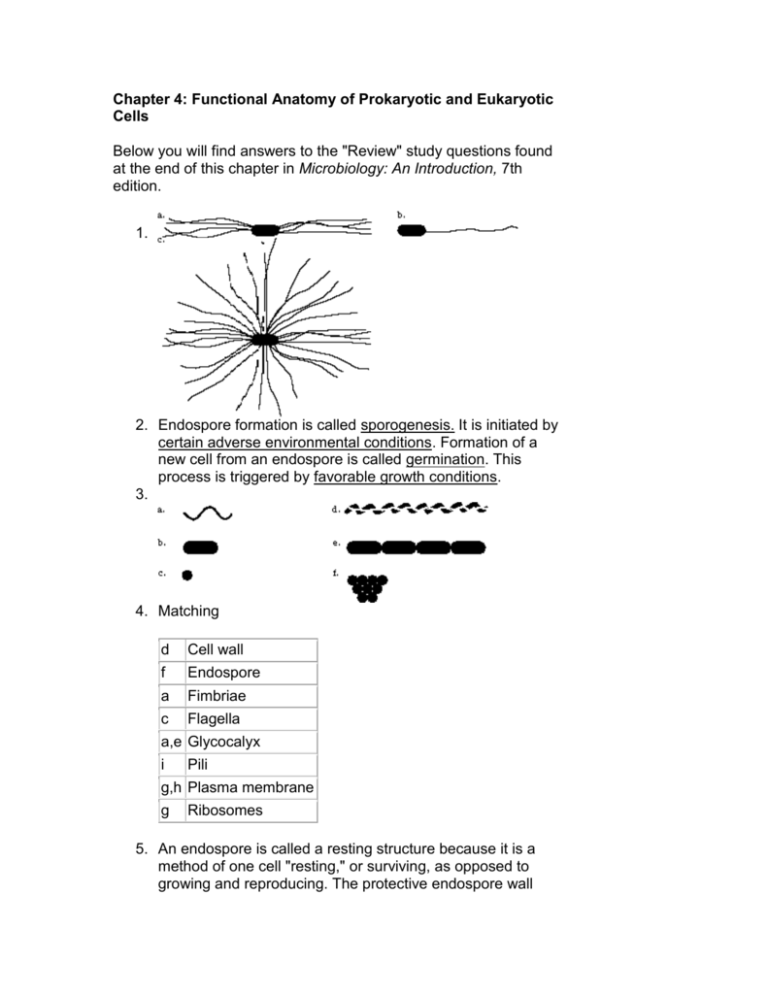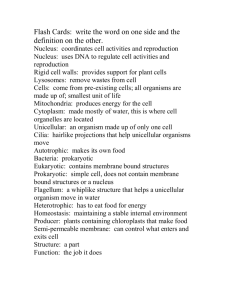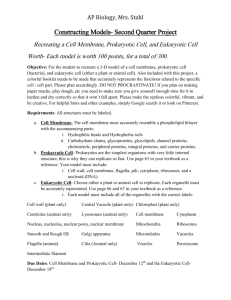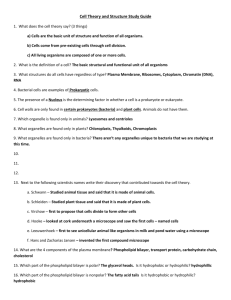Chapter 4: Functional Anatomy of Prokaryotic and Eukaryotic Cells
advertisement

Chapter 4: Functional Anatomy of Prokaryotic and Eukaryotic Cells Below you will find answers to the "Review" study questions found at the end of this chapter in Microbiology: An Introduction, 7th edition. 1. 2. Endospore formation is called sporogenesis. It is initiated by certain adverse environmental conditions. Formation of a new cell from an endospore is called germination. This process is triggered by favorable growth conditions. 3. 4. Matching d Cell wall f Endospore a Fimbriae c Flagella a,e Glycocalyx i Pili g,h Plasma membrane g Ribosomes 5. An endospore is called a resting structure because it is a method of one cell "resting," or surviving, as opposed to growing and reproducing. The protective endospore wall allows a bacterium to withstand adverse conditions in the environment. 6. a. Both allow materials to cross the plasma membrane from a high concentration to a low concentration without expending energy. Facilitated diffusion requires carrier proteins. b. Both require enzymes to move materials across the plasma membrane. In active transport, energy is expended. c. Both move materials across the plasma membrane with an expenditure of energy. In group translocation, the substrate is changed after it crosses the membrane. 7. Mycoplasmas do not have cell walls. 8. a. Diagram (a) refers to a gram-positive bacterium because the lipopolysaccharide-phospholipidlipoprotein layer is absent. b. The gram-negative bacterium initially retains the violet stain, but it is released when the outer membrane is dissolved by the decolorizing agent. After the dye-iodine complex enters, it becomes trapped by the peptidoglycan of gram-positive cells. c. The outer layer of the gram-negative cells prevents penicillin from entering the cells. d. Essential molecules diffuse through the gram-positive wall. Porins and specific channel proteins in the gram-negative outer membrane allow passage of small water-soluble molecules. e. Gram-negative. 9. An extracellular enzyme (amylase) hydrolyzes starch into disaccharides (maltose) and monosaccharides (glucose). A carrier enzyme (maltase) hydrolyzes maltose and moves one glucose into the cell. Glucose can be transported by group translocation as glucose-6-phosphate. 10. Matching c Centriole d Chloroplasts g Golgi complex a Lysomomes f Mitochondria b Peroxisomes e Rough ER 11. A mitochondrion is an example of an organelle that resembles a prokaryotic cell. The inner membrane of a mitochondrion is arranged in folds similar to mesosomes. ATP is generated on this membrane just as it is in prokaryotic plasma membranes. Mitochondria can reproduce by binary fission, and they contain circular DNA and 70S ribosomes. 12. Phagocytosis. Pinocytosis. 13. Erythromycin inhibits protein synthesis in a prokaryotic cell; it will inhibit protein synthesis in mitochondria and chloroplasts. Below you will find answers to the "Multiple-Choice" study questions found at the end of this chapter in Microbiology: An Introduction, 7th edition. 1. e 2. d 3. b 4. a 5. d 6. e 7. b 8. e 9. a 10. b Note: The answers to the Critical Thinking and Clinical Applications questions are available to instructors only, and are found in the Instructor's Manual.











